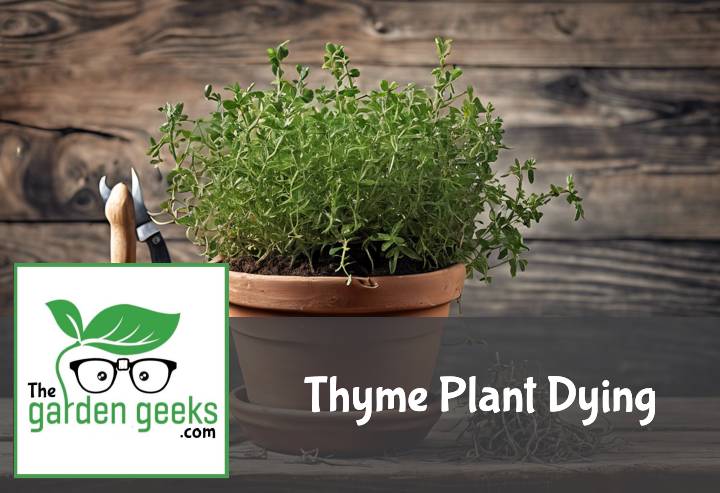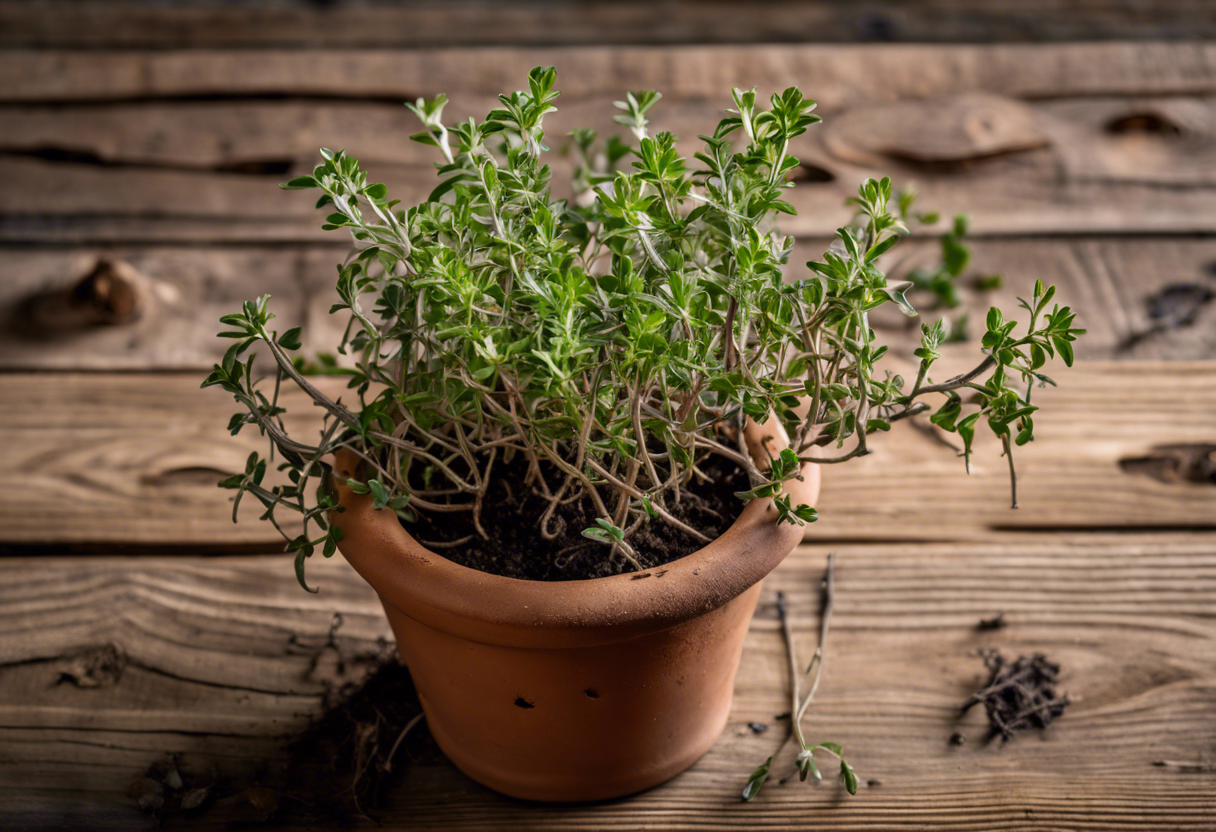Ever found yourself wailing, “Why is my Thyme Plant Dying?” Well, you’re not alone. I’ve been there too, staring at my once vibrant thyme plant now looking more like a Halloween prop.
Don’t despair! Thyme plants can be tricky but they’re also resilient. So pull up your garden gloves and let’s get to work. Keep reading about ‘Thyme Plant Dying? (How to Revive it)’. We’ll turn that brown thumb green in no time!
Key Takeaways
- Thyme plants may die due to overwatering, poor soil drainage, or lack of sunlight.
- To revive a dying thyme plant, reduce watering frequency and ensure the plant gets at least six hours of sunlight daily.
- Improve soil drainage by adding organic matter or sand.
- Prune dead parts to encourage new growth.
- If the plant is severely damaged, propagate new plants from healthy cuttings.
Why is Your Thyme Plant Dying?
Hey there, green thumb! If your thyme plant is looking a bit under the weather, you’re probably wondering why. Well, there could be a number of reasons. From general thyme plant care issues to specific thyme plant problems, it’s not always easy to pinpoint what’s causing your dying thyme plant. But don’t worry, we’re here to help you figure out what might be going wrong and how to get your unhealthy thyme plant back on track.
Common Signs of a Dying Thyme Plant
First things first, let’s talk about the signs. A healthy thyme should have vibrant green leaves and a strong aroma when touched. But if you’ve got wilting or yellowing leaves, that’s a red flag.
Stunted growth in your thymes can also be an indication of trouble brewing. It might seem like they’ve hit the pause button on growing – not good!
Another sign could be dryness. If your thymes are feeling more like sandpaper than soft herbs, that’s another clue something’s up.
And lastly, drooping stems can also signal distress. If your thymes are looking more downcast than usual, it might be time for some TLC.
Possible Causes for a Dying Thyme Plant
Now onto possible causes. One common culprit? Watering – either too much or too little. Overwatering can drown the roots while under-watering can leave them parched.
Next up: sunlight – or lack thereof. Thymes love sunbathing so if they’re stuck in the shade all day, they won’t be happy campers.
Pests are another potential problem area. If you spot any creepy crawlies hanging around your plants, it could mean they’re infested.
Lastly, diseases can also take a toll on your thymes. If you notice any unusual spots or discoloration, it could be a sign of disease.
Remember, figuring out what’s wrong with your thyme plant is the first step to reviving it. So keep an eye out for these signs and causes!
How to Diagnose the Problem with Your Thyme Plant?
So, your Thyme Plant Dying? Don’t worry! It’s time to play detective and diagnose those pesky thyme plant problems. The first step in thyme plant care is a thorough examination of the leaves and stems, followed by an assessment of soil condition and watering practices. Lastly, we’ll look for any signs of pests or diseases.
Examining the Leaves and Stems
When it comes to diagnosing thyme leaf problems, you gotta get up close and personal. Look for discoloration, spots or wilting on the leaves. These could be signs of an unhealthy thyme plant.
Next up, check out those stems! If they’re weak or brittle, you’ve got some stem issues in thymes on your hands. Remember, healthy stems should be sturdy and robust.
Checking the Soil Condition
Now let’s dig a little deeper – literally! The soil condition can make or break your thyme’s health. So grab a handful and give it a good squish. If it feels too dry or too wet, you might have some soil-related issues in thymes.
Also, take note of its color. Dark brown soil indicates good fertility; however, if it’s light-colored or has a strange smell, it might not be providing enough nutrients for optimal thymes growth.
Assessing Watering Practices
Watering – sounds simple enough right? But improper watering can lead to a whole host of problems for your poor thyme plant. Overwatering can cause root rot while underwatering can leave your plant parched!
The key is balance. Your thyme likes its soil moist but not waterlogged. So next time you reach for that watering can, remember: less is often more when it comes to watering plants!
Identifying Pest or Disease Issues
Last but definitely not least, let’s talk about pests and diseases. These uninvited guests could be the culprits behind your Thyme Plant Dying.
Keep an eye out for tiny bugs on the leaves or stems – these could be pests wreaking havoc on your plant. Also, look for any unusual spots or discoloration on the leaves, as these could indicate a disease.
Remember, identifying these issues early is key to saving your thyme plant!
How to Revive a Dying Thyme Plant?
If your Thyme Plant is Dying, don’t lose hope just yet. You can still revive it by adjusting watering techniques, modifying soil conditions, treating pests and diseases, and providing proper pruning and care.
Adjusting Watering Techniques
Watering is a crucial part of Thyme plant care. Too much or too little water can cause your thyme to wither. Overwatering often leads to root rot, while underwatering leaves the plant dehydrated.
To revive your dying thyme plant, you need to strike a balance. Ensure the soil is moist but not soggy. Remember, thymes prefer dry conditions over wet ones.
Modifying Soil Conditions
Soil plays a significant role in the health of your thyme plant. If you’re looking to save your withering thyme, consider modifying the soil conditions.
Thymes thrive in well-draining soil with an optimal pH level between 6 and 8. Adding organic matter like compost can also improve soil fertility and structure, promoting healthier growth.
Treating Pests and Diseases
Pests and diseases are common culprits behind ailing thymes. Aphids, spider mites, and fungal diseases like powdery mildew can wreak havoc on your plants.
To combat these issues, use organic pest control methods or fungicides specifically designed for Thymus vulgaris. Regularly inspect your plants for signs of disease or infestation to catch problems early on.
Pruning and Care Tips
Pruning is an essential part of thyme revival methods. It helps maintain the shape of the plant and encourages new growth.
When pruning, focus on removing dead or diseased parts first. Then trim back about a third of the remaining plant to encourage bushier growth.
Aside from pruning, remember that thymes love sunlight. Ensure your plant gets at least six hours of sun each day for optimal health.
Preventive Measures to Keep Your Thyme Healthy
Preventive measures are the secret sauce to keeping your thyme plant healthy. They’re like the gym and a balanced diet for us humans. With the right conditions and regular TLC, you can prevent your thyme plant dying and instead enjoy a lush, fragrant herb garden.
Ideal Growing Conditions for Thyme
Thyme is a sun-loving herb. It’s like that friend who’s always chasing summer! So, ensure your thyme gets plenty of sunlight; we’re talking about at least six hours daily. That’s the thyme sunlight requirement for you!
Now let’s talk soil. The best soil for thyme is well-drained with a neutral to slightly alkaline pH level. Imagine it as the comfy bed where your thyme loves to snuggle in.
Watering needs? Well, thyme isn’t too demanding. It prefers being slightly dry than waterlogged. So, go easy on the watering, folks! Remember, overwatering is often a fast track ticket to having your thyme plant dying.
Regular Maintenance Tips
Maintenance is key when it comes to healthy thyme growth. Think of it as taking your car in for regular services.
First off – pruning! Don’t be scared to give your thyme a good haircut now and then. Regularly pruning thyme plants helps promote bushier growth and prevents woody stems.
Next up – watering schedule! As mentioned earlier, less is more when it comes to watering thyme plants. A good soak once or twice a week should do the trick.
Lastly – feeding time! A little bit of fertilizer can go a long way in preventing thyme diseases and promoting robust growth. Just remember not to overdo it; too much love can be harmful sometimes!
In a Nutshell
Your thyme plant isn’t ready to kick the bucket just yet! Remember, it’s like a finicky cat – it needs just the right amount of light, water, and nutrients. Too much or too little can make it go from purring to hissing!
Don’t let your Thyme Plant Dying be the end of your herb garden dreams. Keep these tips in mind and give it another shot! You got this, green thumb!





